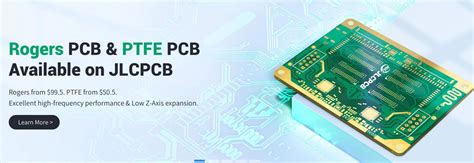Introduction to Rogers and PTFE Materials
Rogers and PTFE (polytetrafluoroethylene) are two distinct materials with unique properties and applications. Both materials are widely used in various industries due to their exceptional characteristics. In this article, we will explore the differences between Rogers and PTFE materials, their properties, applications, and frequently asked questions.
What is Rogers Material?
Rogers is a brand name for a family of high-performance materials, including laminates, adhesives, and elastomers. These materials are engineered to provide excellent electrical, thermal, and mechanical properties. Rogers materials are known for their low Dielectric constant, low loss tangent, and high thermal conductivity, making them ideal for use in high-frequency and high-speed applications.
Types of Rogers Materials
- Rogers RT/duroid® Laminates
- Rogers RO4000® Series Laminates
- Rogers CLTE Series™ Laminates
- Rogers COOLSPAN® Adhesive
- Rogers BISCO® Silicones
What is PTFE?
PTFE, or polytetrafluoroethylene, is a synthetic fluoropolymer known for its excellent chemical resistance, low friction coefficient, and high thermal stability. It is a non-reactive, non-stick material that can withstand extreme temperatures and harsh chemicals. PTFE is often referred to by its trade name, Teflon, which is a registered trademark of The Chemours Company.
Properties of PTFE
- High chemical resistance
- Low friction coefficient
- Non-stick surface
- Wide operating temperature range (-200°C to 260°C)
- Excellent electrical insulation properties
PTFE-PCB/”>Rogers vs PTFE: Key Differences
While both Rogers and PTFE materials offer unique properties, there are several key differences between them:
| Property | Rogers | PTFE |
|---|---|---|
| Composition | Engineered materials (laminates, adhesives, elastomers) | Synthetic fluoropolymer |
| Dielectric Constant | Low (2.2 to 3.5) | Low (2.1) |
| Loss Tangent | Low (0.0009 to 0.003) | Very Low (0.0002) |
| Thermal Conductivity | High (0.6 to 2.5 W/mK) | Low (0.25 W/mK) |
| Chemical Resistance | Good | Excellent |
| Mechanical Strength | High | Moderate |
| Applications | High-frequency and high-speed electronics | Non-stick coatings, seals, bearings |
Dielectric Properties
Rogers materials are engineered to have low dielectric constants and low loss tangents, making them suitable for high-frequency applications. PTFE also has a low dielectric constant, but its loss tangent is even lower than that of Rogers materials.
Thermal Properties
Rogers materials have high thermal conductivity, allowing for efficient heat dissipation in electronic applications. PTFE, on the other hand, has low thermal conductivity, which can be advantageous in applications requiring thermal insulation.
Chemical Resistance
PTFE is known for its excellent chemical resistance, making it suitable for use in harsh chemical environments. Rogers materials also have good chemical resistance but may not be as resistant as PTFE to certain chemicals.
Mechanical Properties
Rogers materials are engineered to have high mechanical strength, making them suitable for applications requiring durability and stability. PTFE has moderate mechanical strength and is known for its low friction coefficient and non-stick properties.
Applications of Rogers and PTFE
Rogers Material Applications
- High-frequency printed circuit boards (PCBs)
- Microwave and millimeter-wave components
- Antenna systems
- Automotive radar sensors
- Aerospace and defense electronics
PTFE Applications
- Non-stick coatings for cookware and bakeware
- Seals and gaskets for chemical processing equipment
- Bearings and bushings for low-friction applications
- Electrical insulation for wires and cables
- Medical devices and implants

Frequently Asked Questions (FAQ)
-
Q: Can Rogers materials be used in high-temperature applications?
A: Yes, some Rogers materials, such as the BISCO® Silicones, are designed to withstand high temperatures and maintain their properties in extreme conditions. -
Q: Is PTFE safe for use in food contact applications?
A: Yes, PTFE is FDA-approved for use in food contact applications due to its non-toxic and non-reactive properties. -
Q: How do Rogers materials compare to other high-frequency laminates?
A: Rogers materials offer a unique combination of low dielectric constant, low loss tangent, and high thermal conductivity, making them superior to many other high-frequency laminates in terms of performance and reliability. -
Q: Can PTFE be used in cryogenic applications?
A: Yes, PTFE maintains its properties at extremely low temperatures, making it suitable for use in cryogenic applications down to -200°C. -
Q: Are Rogers materials environmentally friendly?
A: Many Rogers materials are designed with sustainability in mind, using halogen-free and lead-free compositions. The company also has initiatives in place to reduce its environmental impact and promote responsible manufacturing practices.
Conclusion
Rogers and PTFE are two distinct materials with unique properties and applications. Rogers materials are engineered for high-frequency and high-speed electronics, offering low dielectric constants, low loss tangents, and high thermal conductivity. PTFE, on the other hand, is known for its excellent chemical resistance, low friction coefficient, and non-stick properties, making it suitable for a wide range of applications, from non-stick coatings to seals and bearings.
When choosing between Rogers and PTFE, it is essential to consider the specific requirements of your application, such as frequency, temperature, chemical exposure, and mechanical stress. By understanding the key differences between these materials and their properties, you can make an informed decision and select the most suitable material for your needs.

No responses yet